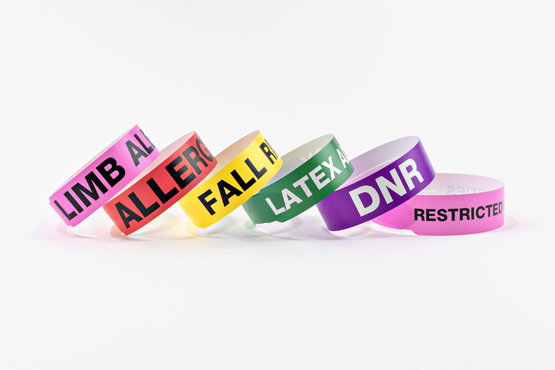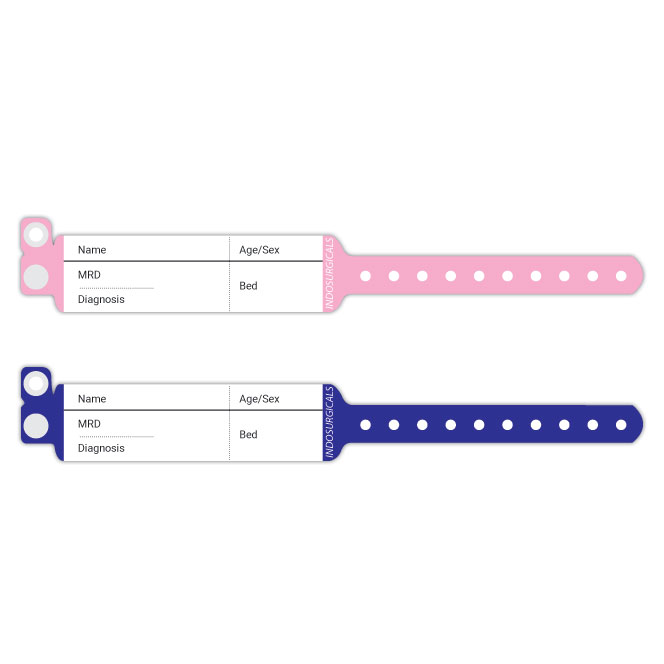How to Ensure the Security and Precision of Patient Information with a Patient Identification Band
How to Ensure the Security and Precision of Patient Information with a Patient Identification Band
Blog Article
Checking Out the Different Types of Patient Identification Band Utilized in Medical Facilities
In the detailed globe of medical care, the essential role of Patient Identification bands often goes undetected. These bands, varying from simple paper wristbands to innovative RFID bands, create the foundation of Patient safety methods, making sure precision in Patient Identification. Yet, the vast variety of these bands, each with its distinct advantages and restrictions, is frequently overlooked. As we navigate via this topic, one might acquire understanding into the refined complexities and important significance of such bands in clinical centers.
Comprehending the Significance of Patient Identification Bands
While they might seem like plain devices, Patient Identification bands play a crucial function in medical facilities. These bands offer as a critical tool for confirming Patient identification, stopping medical errors related to misidentification. Patient Identification bands also aid in streamlining management tasks, guaranteeing accurate record-keeping and billing.
Typical Paper Wristbands: Their Usage and Limitations
Typical paper wristbands have actually been a staple in Patient Identification across various medical facilities. While their usage is widespread, they nurture specific limitations that might affect their effectiveness in Patient monitoring. This area will concentrate on the range of their application and the fundamental drawbacks linked with their use.
Paper Wristbands: Usage Extent
In the realm of Patient Identification, paper wristbands have long held an essential duty. These bands are typically made use of in outpatient settings, where the Patient's stay is short-lived. The wristbands include crucial info such as the Patient's name, date of birth, and an unique Identification number. This simple, yet reliable system, allows clinical professionals to swiftly and precisely recognize individuals, ensuring the right therapy is administered. Paper wristbands are also used in emergency circumstances, where rapid Identification is paramount. Their use expands to events like blood contribution drives and mass inoculation programs, even more stressing their flexibility. In spite of advancements in modern technology, the humble paper wristband stays a economical and reliable service for Patient Identification in different medical care circumstances.
Limitations of Paper Wristbands
Despite their prevalent usage, paper wristbands are not without their downsides. In addition, paper wristbands frequently do not have the technical capabilities of even more modern options, such as barcoding or RFID chips, limiting their performance to merely showing written details. Paper wristbands can trigger pain or skin irritation to some people, especially when used for extended periods.
Barcoded Wristbands: Developments in Patient Identification
While Patient Identification has actually long been a critical aspect of healthcare, the introduction of barcoded wristbands indicates a substantial leap forward. These bands leverage the simplicity of barcoding technology, allowing for Patient details to be quickly scanned and accessed. They boost the rate and accuracy of Patient Identification, reducing the threat of medical errors related to misidentification.
Radio Frequency Identification (RFID) Bands: an Action Towards Futuristic Health Care
The evolution of Patient Identification bands has actually caused the appearance of Radio Regularity Identification (RFID) Bands (patient identification band). These innovative devices existing crucial benefits for medical care centers, offering an extra effective and technically progressed means of Patient Identification. The application of RFID in health care is a considerable step in the direction of a much more futuristic method to Patient administration and security
Understanding RFID Bands

RFID Bands: Trick Advantages
Embracing a future where technology and medical care combine, superhigh frequency Identification bands offer numerous crucial advantages. Mainly, these bands improve Patient security by offering exact, immediate Identification, thus reducing clinical mistakes. RFID bands can store a vast quantity of Patient data, consisting of case history and allergic reactions, allowing personalized treatment. They likewise streamline management tasks, as the automated data entry changes hands-on procedures, enhancing efficiency and lowering documentation. Moreover, RFID bands provide real-time monitoring of Home Page people, important in high-risk settings such as surgical treatment or intensive treatment. Lastly, these bands are resistant and resilient to ecological factors, guaranteeing regular performance. Generally, RFID bands represent a substantial development in Patient Identification technology, benefiting both people and doctor.
Applying RFID in Healthcare
These bands offer a smooth way to track and recognize clients, guaranteeing have a peek at this website their security and improving performance in treatment procedures. RFID bands decrease medical errors by giving precise Patient Identification, which is critical in stopping misdiagnosis or wrong medication management. Hence, the implementation of RFID bands is a substantial action in the direction of enhancing Patient security and medical care delivery.

Color-Coded Wristbands: Aiding in Quick and Accurate Diagnosis
In the busy environment of a medical center, color-coded wristbands have actually emerged as crucial devices for swift and precise Identification of a person's medical condition. These wristbands, put on by people, carry certain shades that correspond to various medical conditions or conditions. This system is made to offer instant aesthetic signs to healthcare carriers, enhancing Patient security and care high quality.
Approaches for Effective Implementation and Administration of Patient ID Bands
Attaining optimal use of Patient Identification bands necessitates a well-structured technique for their application and management. The very first step includes training all health and wellness employees on the relevance of appropriately using and reviewing these bands. Second of all, medical facilities must standardize making use of ID bands throughout all divisions, making certain harmony and lowering disparities. Routine audits needs to be performed to validate adherence to plans and to correct any disparities. Patient education and learning is likewise essential; people must recognize the function of the bands and the need for their constant wear. patient identification band. Finally, it's vital to have a back-up plan in location, such as barcode scanning or biometrics, to guarantee that Patient Identification is never endangered.
Verdict
Patient Identification bands are critical in medical facilities to make sure safety and security and accuracy. Effective implementation and administration of these bands can dramatically important link reduce medical errors, increase effectiveness, and enhance total Patient treatment.
These bands, differing from simple paper wristbands to advanced RFID bands, develop the backbone of Patient security methods, ensuring precision in Patient Identification.The evolution of Patient Identification bands has actually brought concerning the introduction of Radio Regularity Identification (RFID) Bands. Overall, RFID bands represent a significant development in Patient Identification technology, benefiting both clients and health care suppliers.
RFID bands lower medical mistakes by giving exact Patient Identification, which is important in stopping misdiagnosis or wrong medication management. Patient education and learning is likewise important; clients need to understand the purpose of the bands and the demand for their consistent wear.
Report this page